This is the first part of an essay series which takes as its inspiration something Wendell Berry said in The Unsettling of America: “Over and over again, spring after spring, the questing mind, idealist and visionary, must pass through the planting to become nurturer of the real.” Resounding in the background, too, as if across an empty canyon where our hearts used to be, is Vine Deloria's rhetorical question to the sunset of the West: “Can the white man's religion make one final effort to be real?”
Note » Scroll all the way down for 1) a easily printable PDF and 2) a pleasantly soundscaped audio version of the essay.
Grandfather, Great Mysterious One!...There is nothing to pray to but you. The star nations all over the heavens are yours, and yours are the grasses of the Earth...Day in, day out, you are the life of all things. Grandfather, all over the world the faces of living ones are alike. In tenderness they have come up out of the ground...
– Black Elk's prayer, in When the Tree Flowered, by John Neihardt
I am a treehugger in the sense of being someone who literally puts his arms around trees and embraces them (he said, to the surprise of no one).
In college I thought “treehugger” was just a pejorative turn of phrase to describe people who love nature too much, but I had a crazy friend whom I cherished, who said to me one time as we were strolling through a garden on the way to the dining hall, “Giant trees are full of love, Graham, you should hug one, it'll probably help with your anxiety.”
And so I did—I bear-hugged the nearest red pine. It was so huge I could only get my arms maybe a third of the way around, but I held on tight, with my heart pressed right up against the bark, and my mouth and face, too, nostril-breath full of its fragrant sap.
And since I'm well beyond the point of caring whether you think I've lost my mind, I'll just tell you exactly what it was like: Gentle waves of compassion crashing quietly against the shores of my empty ribcage, heart softening, deeply touched...
The tree was alive in the deepest sense.
My friend was right; it did help with my anxiety. I think it ruined me for Christian normalcy, though—at least in the orthodox mainstreams still flowing from the dream consciousness of the holy ecumenical councils.
In his novel Dartmouth Park, Rupert Thomson follows the spiritual journeys of a man suffering from a kind of hyper-industrial, Machine-world vertigo:
If he suddenly found what surrounded him unbearable, it was because it was artificial
Everything had been designed and manufactured, and he was trapped in it
He had also become aware of possibilities that might or might not have been explored
Behind that beep, a thousand other beeps
Behind that upright orange metal pole, a pole made out of something different
[And] somehow all the conceivable alternatives were still there, stacked up behind the version that had been decided on
Describing what it's like to live with this kind of see-through vision of the manufactured world, Philip—the protagonist—laments to his cab driver, who didn't ask:
My problem is this, Philip told the driver
Everything I see around me has been thought about
Everything has been made
...I have a sense of duplication, a feeling of superfluity, it's too much to take in, it's like a kind of bombardment
...He paused
If I'm looking a tree, there's only a tree
...It's more restful, the driver said
Yes, Philip said
That's a good way of putting it
In the sacred spaces where I've been trying to find roots these last thirteen years, I've been surrounded by a lot of these:
—wooden panels, sometimes handpainted, sometimes silkscreened, but most often just laminated and mass produced, depicting the faces of people who seem like they don't want to be here.
Here, meaning Earth. As if, if there's a home for them anywhere, it's in another, higher world—the world of ancient Byzantium up in the Maxfield Parrish clouds, perhaps, or the crypts of Fayum, Egypt.
If it were me, not Philip, pouring my heart out to the cab driver, I would tell him—unasked, of course, just like I'm telling you—that what my problem is, is that I can't unsee the original, living, sky-breathing green-leafed tree that was crashed over with some machine, then cut up into boards and laminated, to make it into something holy.
Because I know what it's like to sit quietly in the shade of Brother Oak or Sister Birch, like a tiny goofball Abraham among the vast terebinths of Mamre, a sense of the Holy One's presence slowly awakening as warm beams of sunlight in the heart, the trees and I breathing the sky together—that makes sense, I can do that: I know what it's like to touch directly, if only fleetingly, the truth that all living things in God have a face...
But when people with a stronger religious sense than I do stand before an icon of the Queen of Heaven or Michael or Gabriel or Tsar Nicholas II and feel their presence, I don't know what that is. It seems maybe they're using their imaginations in a way that I, for whatever reason, either can't, or won't. Whereas to feel the presence of a living tree in a tree that's still alive requires no Atlantian lifting at all, since the tree is really there.
In the cab, Philip describes the omnipresence of the manmade world as a superfluity, as too much to take in, a kind of bombardment—which, forgive me, brothers and sisters, is how I feel, too, in sacred spaces which close themselves off from the living, breathing world of the original Creation, by erecting walls of some other reality blocking out sun and trees and sky:
Many people find spaces like this beautiful; many people these days are fleeing into them from the hostile ugliness of elsewhere, and I don't blame them.
As for me, though, even on my best days of going to church, I often walked right out again and went walking among the trees down by the water, finding in them more rest, more stillness and peace. I long for the world that Philip stumbled across, momentarily at least, near the end of Dartmouth Park, outside the walls of a monastery in Cyprus, a world, I think, which is really just the real world itself:
There were no intrusions, no distractions—only sun and wind and stones and prayer and sky
Things could make the impression they were meant to make
In what's become for us a kind of sacred dreamtime of holy ecumenical councils, it's not enough for the living beings of Creation to make the impression they were meant to make. Vast trees rooted in the brown Earth, vast arms reaching out with hands of green for blue sky and yellow sun, must be turned into images of human people or angelic beings—simulations, basically—and those images must hang suspended in space before our faces as we reach out for the face of the Living God in our prayers—this is the decree of the Fathers of the Seventh Ecumenical Council:
The sacred icons of our Lord Jesus Christ are to be had and retained...and those which represent our undefiled Lady, the holy Mother of God; and likewise those of the Holy Angels...or of any of the Saints...[We have likewise decreed] that these images are to be reverenced (προσκυνεῖν), that is, salutations are to be offered to them. The reason for using the word is, that it has a two-fold signification. For κυνεῖν in the old Greek tongue signifies both “to salute” and “to kiss.” For that which one loves he also reverences (προσκυνεῖ) and what he reverences, that he greatly loves—as the everyday custom, which we observe towards those we love, bears witness—and in which both ideas are practically illustrated when two friends meet together....For it is written in the histories of the Kings, “And David rose up and fell upon his face and did reverence to (προσεκυνήσε) Jonathan three times and kissed him.”
Already here in the year 787, I see the seed of an orientation towards virtual reality which will blossom rather fiercely in 2020. For, just as two friends in the ancient Hebrew world, who loved and cherished and honored and adored one another might, upon seeing one another in the skin-bag of the precious human flesh, touch their foreheads three times to the Earth, then stand up and give each other the threefold kiss of peace, so also should Christian true believers make prostrations before manufactured images and mosaics of the holy ancestors and stand up and kiss them, say the Fathers—as if they were our friends.
As if the great chasm of their absence, or at least nonbodily presence, could be leapt across by the twin horses of visual technology and the spiritual imagination.
“Should,” not “can” or “may”:
And if anyone does not so believe, but undertakes to debate the matter further...such a one our holy ecumenical council (fortified by the inward working of the Spirit of God, and by the traditions of the Fathers and of the Church) anathematises. Now anathema is nothing less than complete separation from God.
That, too, is some pretty vividly imaginative wandering through a kind of virtual reality on the part of the Fathers—that just by writing a letter to the emperor and empress, they could separate other people from the love of God forever.
Well, that was the late eighth century, dealing with late eighth century problems. The nearer in time you get to Christianity's early Hebrew roots, though, the more you still see Hebraic attitudes about what bowing to images does to the human person—that “those making them become like them” (Ps. 115:8).
You can see this in the words of the second century pagan critic, Celsus, who complained of Christians that
They cannot tolerate temples, altars, or images. In this they are like the Scythians, the nomadic tribes of Libya, the Seres who worship no god, and some other of the most barbarous and impious nations in the world.
(Origen, Against Celsus, LXII)
You Jesus freaks are ungovernable desert scum, Celsus was saying. You're basically atheists.
His opponent in the next century, Origen of Alexandria, totally agreed. He didn't say what the Fathers of the Seventh Ecumenical Council would have had to say, which was that of course we have temples and altars—and, after about fifty years of icon-bashing mayhem, we're about to have holy images again, too. Instead, what he said was, was that Christians
not only avoid temples, altars, and images, but are ready to suffer death when it is necessary, rather than debase by any such impiety the conception which they have of the Most High God. (Against Celsus, LXIV)
And he also said that “we impress upon the minds of our first converts a contempt for idols, and images of all kinds” (XV) and he said that those who are “taught in the school of Jesus Christ have rejected all images and statues” (XLI), since “it is not possible at the same time to know God and to address prayers to images” (LXV).
But, yes, I do get that many ancient and venerable spiritual traditions have used sacred images as a way to concentrate and localize the divine, insofar as these images help the believers themselves concentrate and localize their own powers of attention.
That, basically, has been the normal religious thing to do—at least in massively complex civilizations almost entirely abstracted from nature.
Which is one reason, among many, why the ancient Hebrews were so strange to their neighbors. They'd been shown something so profound, so subversive to the ordinary, human, religious impulse, that it's hard to put in words—and, in fact, they ended up building it into their sacred architecture itself, where the vast air above the cherubim took the place of the divine image that, in the ancient Near Eastern idiom, would otherwise have been sitting, thus enthroned. As if so to say: No dead images of the Living God.
On this note, I find it profound that Yeshua himself, who said “If you've seen me, you've seen the Father” insisted only that we give our visual attention to the birds and flowers:
Look at the birds of the air. They do not sow or reap or gather into barns; yet your Father in the sky feeds them. Look closely at the lilies of the field, how they grow. They neither toil nor spin, yet I tell you that not even Solomon in all his radiance clothed himself like one of these. (Mt. 6:26-29)
The Greek of this “look closely” or “gaze intently” is katamathete, which means literally to “learn” them “down”—to gaze at the lilies of the field so well, they penetrate down to the heart and take root there and stay: To look deeply into them—to become awake with them, living face to living face.
“The eye is the lamp of the body,” Yeshua had said, just before all this about the lilies and the birds. “If your eye is good, your whole body will be full of light.” Which, to me, echoes of Genesis, where the relationship between the Holy One and his Creation is itself described as a kind of vividly intense gaze, filling the body of Earth with light:
God said, “Let there be light!” and there was light
And God saw [ra'a] that the light was good
And God said, “Let dry ground appear”
And it happened so—and God saw [ra'a] that it was good
And God said, “Let the land sprout grass, green plants yielding seed, fruit trees making fruit”
And it happened so—and God saw [ra'a] that it was good
And God said, “Let the waters swarm with swarms of living creatures! Let flying creatures fly above the land across the expanse of the sky!”
And God saw [ra'a] that it was good, and God blessed them by saying
“Be fruitful and multiply and fill the water in the seas!”
And God said, “Let the land bring forth living creatures”
And it happened so—and God saw [ra'a] that it was good
And God created humankind in his image,
And God saw [ra'a] everything that he made
And behold it was very good...
The living things of Earth, which come from God, can awaken new life within us—like a fresh breeze—in a way that artifacts of other peoples' religious imaginations can't.
Letting a tree be a tree, letting a stone be a stone—letting the birds of the air and the flowers of the field be songbirds and blooming flowers—we can gaze deeply into them, and walking with Yeshua, as it were, up to our waists in white lilies, perhaps learn to co-see them all with God—to see them as he does, not as “fallen” or alienated from what's really real, but as “very good,” full of inner light.
The Fathers were right, though: Ransacking temples, defacing them in a kind of self-righteous annihilation of the old order—that's its own kind of vain darkness, far worse than slipping away into whatever idolatry those images may or may not have entailed.
Nor does it really work to keep on building temples in the old way, only with all the sacred images gone. After unleashing the bull of heaven against ecclesiastical beauty, this is the pattern many Protestant rebels settled into, but it seems to have ended in our times in a kind of architectural nihilism which intensifies, rather than alleviates, spiritual pain:
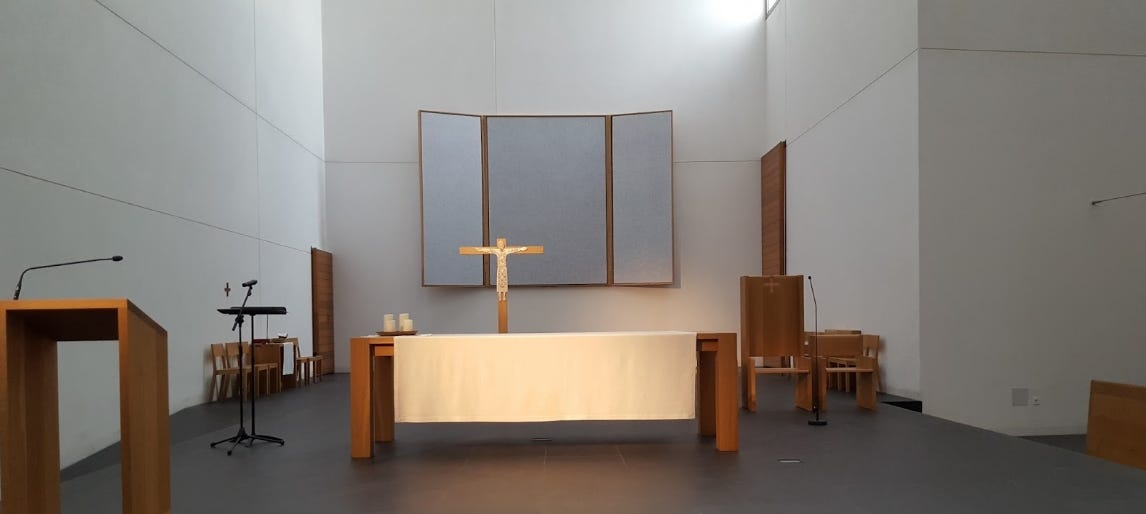
The way forward is neither destroying sacred images cherished by others, nor carrying on with their way of making temples, only minus the images without which those temples become lifeless and incoherent.
The way forward is perhaps just to quietly walk away.
I think it might be. After all, what Origen said to Celsus, when Celsus was foaming at the mouth at all these irreligious Christians everywhere not having temples, altars, or images, was simply: “The whole universe is God's temple” (XLIV).
The Earth and sky as God's only temple; as its only images, the faces of all living beings—cypress trees, blue morpho butterflies, and purple hyacinths, and cooing doves, and radiantly headstrong iridescent pigeons sifting through our yellow McDonald's trash, and all of us beautiful, suffering human beings, dancing and singing, and blades of green grass pushing up through black asphalt on the roofs of our fractured towers of Babylon: Why not?
I mean actually: Why not? “There were no temples or shrines among us save those of nature,” said the great Sioux Indian of yesteryear, Ohiyesa Charles Eastman,
[And] being a natural man, the Indian was intensely poetical. He would deem it sacrilege to build a house for Him who may be met face to face in the mysterious, shadowy aisles of the primeval forest, or on the sunlit bosom of virgin prairies, upon dizzy spires and pinnacles of naked rock, and yonder in the jeweled vault of the night sky! He who enrobes Himself in filmy veils of cloud, there on the rim of the visible world where our Great-Grandfather Sun kindles his evening camp-fire, He who rides upon the rigorous winds of the north, or breathes forth His spirit upon aromatic southern airs, whose war-canoe is launched upon majestic rivers and inland seas—He needs no lesser cathedral! (The Soul of the Indian)
Ohiyesa was a Christian, by the way, a living bridge between the worlds. And of those two worlds he said:
I believe that Christianity and modern civilization are opposed and irreconcilable, and that the spirit of Christianity and of our ancient religion is essentially the same.
If true, this is an ancient spirit we must have lost touch with somewhere along the way—but can surely touch again, if we want to.
In this series of essays, I hope to reach out for it as best I can.
And I hope you'll come along, too.
love always in Messiah,
our gentle shepherd-king,
in whom is true life, radiance, deep harmony, and everlasting peace,
-graha

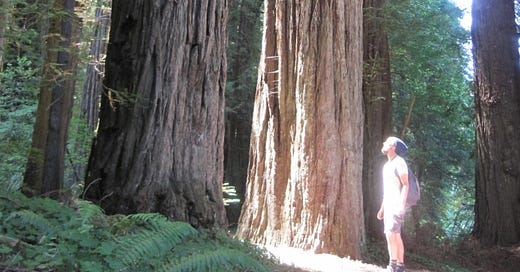





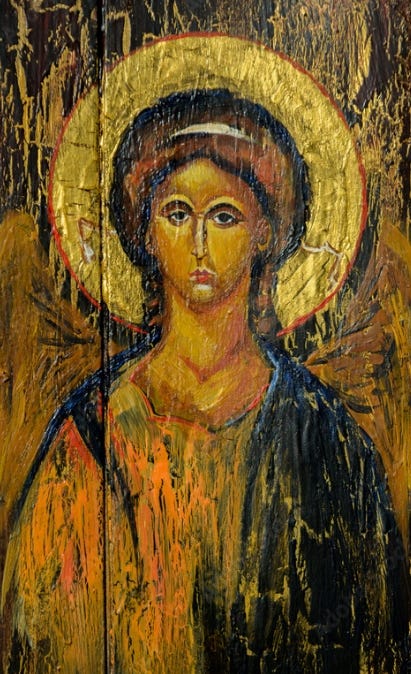
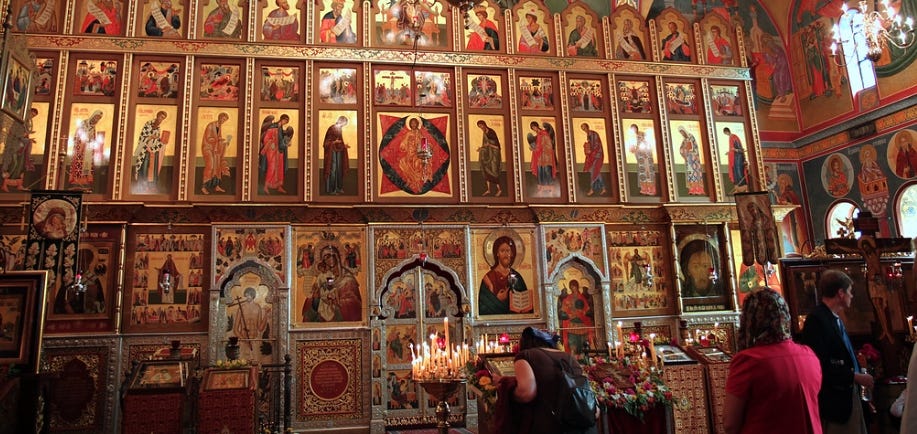
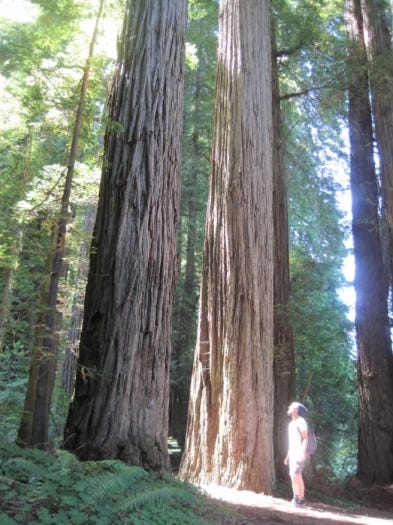



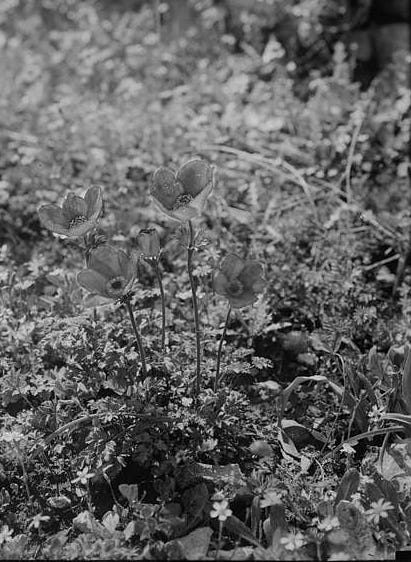

One more thing.
“Cathedrals
The first breaths of spring are here. It’s another foggy morning as dew-dripping grass unfurls in the quiet dawn. Sparkling silver drops hang from a thousand webs, intricate patterns hidden in shadow suddenly blaze to life, quivering in the splendor of the day's first breath. My backyard is a jeweled cathedral, pulsing and singing as the wet and the light raise life from the stillness. Every breath, every birdsong and tiny living thing crawling through the rich greenness is breaking into a melody--the rhythmic, holy song of a reborn earth.
My backyard is a doorway to the truth in myth. The realm of the mythic, that first glimpse of the everyday transformed into something larger, more powerful and primal, is perhaps the deepest plane of truth because it bypasses the mind and speaks straight to the soul. It is here that the Spirit teaches us life itself, with sound and breath and light, he teaches us to wait, to sing and to be, simply as we are. Mythic truths everywhere, once you learn to see them. They’re not only found on mountain tops; they are hidden in the commonplace as well. Don’t turn away without seeing, without reaching a little higher and a little further into the startling mysteries that surround us.
To be still and and hear the morning song in the spring is one of the great gifts one can receive from the life-giver. It is a revelation of about who he is, what he likes, how he talks. Not words from a book, but a living song we can join ourselves, here and now. God is drawing us to himself through his own work. Here, in the backyard, the truth is rebirth. All around there is the sound of becoming. Every blade of grass, every bird and gust of wind is becoming what it must. Here is the quiet to pray and ask, what must I become?
A cathedral is a place of worship. To be overcome by beauty, truth and love is to become one with the same force that calls spring out of winter, life out of death. It is worship. Life in the spirit is not a bunch of dire warnings and fearful thoughts; it is freedom to finally put down all the burden of endless thought, a chance to be present and see and hear what is around us. I think sometimes there are many ways to be born again. The experience is simply waiting for discovery. We are surrounded by cathedrals.”
- Anonymous
I think that part of our image-bearing is to participate as creators ourselves (or more accurately, sub-creators, per Tolkien). So we take wood and make icons, we take grapes and make wine, we take breath and make songs - it's the work we're given to do, and how we participate as sons and not slaves in the divine.